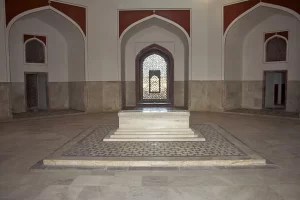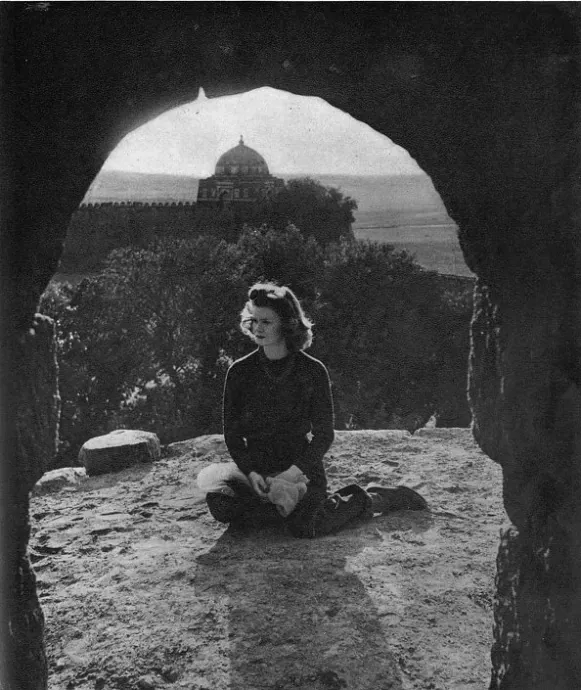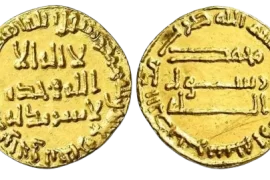The Tomb of Humayun, located in Delhi, India, is a stunning example of Mughal architecture and design. Constructed in the mid-16th century, the tomb is one of the earliest examples of the distinctive Mughal style that would later become synonymous with Indian architecture. The tomb was built by Empress Bega Begum, the widow of the Mughal Emperor Humayun, and is an enduring symbol of his life and legacy.
Historical Context and Background

Humayun was a key figure in the Mughal Empire. He ruled India twice –from 1530 to 1540, and from 1555 until his death on January 24, 1556. He was the second Mughal emperor, succeeding his father Babur, who founded the empire in 1526. During his reign, Humayun expanded the Mughal Empire’s territory, but he also faced significant challenges, including opposition from regional governors and conflicts with other powerful rulers in the region.

Death of Humayun
On January 20, 1556, Nasir al-Din Muhammad Humayun appeared on the rooftop of his library in Din-Panah, Delhi. He remained there for a few hours, visible to the people gathered at the nearby Jami Masjid. Later that day, he called for his mathematicians to calculate the precise time of Venus’ rising. As the day drew to a close, he began to descend the library stairs but paused on the second step upon hearing the muezzin’s call to prayer. Tragically, his foot got tangled in his robe, causing him to fall and hit his head on the ground, according to contemporary historians. He was critically injured and remained in that state for three days before passing away on January 24, 1556, at the age of fifty-one.
Construction of Humayun’s Tomb
After his death, Humayun’s body was placed in a temporary tomb located in his palace in Delhi. However, Khanjar Beg relocated it to Sirhind, Punjab, soon after. Two years later, Humayun’s son and heir, Akbar, visited the tomb. The body was brought back to Delhi at some point before 1568, as documented in Akbarnama. Akbar visited his father’s nearly completed mausoleum at that time. The construction of the tomb was completed in 1572.
Who built the Tomb of Humayun?
The builder of the tomb of Humayun, the Mughal emperor, has been a subject of debate among scholars. While there are no contemporary Mughal references to the monument’s builder, some scholars have suggested that Humayun’s widow, Bega Begum AKA Haji Begum, was responsible for its construction. However, this theory seems unlikely because she was on a pilgrimage to Mecca for much of the time when the tomb was being built.
The most likely candidate for the builder of the tomb is Humayun’s son Akbar, who was the Mughal emperor from 1556 to 1605. Both Abu’l Fazl, Akbar’s official biographer, and Father Monserrate, a Jesuit priest who resided at the emperor’s court during the early 1580s, confirm that Akbar was the builder of the tomb. Abu’l Fazl states that Haji Begam was put in charge of the tomb upon her return from one of her pilgrimages, implying that the emperor was in control of the project. On the other hand, Monserrate writes simply and clearly that Humayun was buried in a sepulcher built by Akbar.
Given the grandeur, cost, and complexity of the mausoleum, it is highly likely that only an individual with immense wealth, power, and artistic taste like Akbar could have built it.
Mirak Mirza Ghiyas, an architect of Iranian descent, designed the mausoleum, as per Abd al-Qadir Badauni’s Muntakhab at-Tavarikh, one of the few historians from that time to mention the construction of the tomb. Mirza Ghiyas had previously worked in Herat, Bukhara, and India before taking on the project of designing Humayun’s tomb, which took place between 1562 and 1571.
Location and surroundings of the Tomb
The Tomb of Humayun is located near Jamuna River. The tomb of Humayun is surrounded by an awe-inspiring collection of monuments from both the Sultanate and Mughal eras (fig. 1). The walls of the city of Din-panah, now known as Purana Qila, founded by Humayun in 1533, are situated 1,500 meters to the north, adding a sense of historical significance to the area. To the west, located 650 meters away, is the dargah and village of Nizam al-Din Awliya, a revered Chishti saint from medieval India, offering a spiritual ambiance to the surroundings. On the east, one can find the chillakhana of Nizam al-Din and the picturesque Jumna river, further enriching the site’s cultural and natural beauty.
Key features of the Humayun’s Tomb
- The Tomb is a massive red-sandstone and white marble structure built around a rubble core.
- The Tomb rests on a large plinth (6.5m x 99m), made up of 56 cells containing more than 100 gravestones.
- The Tomb is located in the center of an enclosed garden.
- The elongated drum and double dome of the monument tower are 42.5 above the ground.
- The tomb’s shape is not a typical square, as its corners are chamfered, resulting in an irregular octagon appearance.
- The mausoleum’s design is made up of four distinct octagonal units, which are divided by four recesses, giving the structure a unique and captivating appearance.
Architecture and Design of the Tomb of Humayun
The Tomb of Humayun is an impressive architectural feat, featuring a symmetrical layout and intricate geometric designs. The tomb is located in the center of a large garden, which is divided into four quadrants by causeways and water channels. The garden itself is laid out in a Persian-style “charbagh” or “four-fold garden,” a common feature of Mughal architecture.
The tomb itself is a large structure, made primarily of red sandstone with marble accents. The central chamber houses Humayun’s cenotaph, or empty tomb, while smaller rooms around the central chamber were used for prayer and other religious functions. The tomb is topped with a large dome, which is decorated with intricate geometric patterns and Islamic calligraphy.
Symbolism and Meaning
The Tomb of Humayun is rich with symbolism and meaning, both in terms of its design and its place in Mughal culture and society. The use of water in the garden, for example, was symbolic of the four rivers of paradise in Islamic tradition. The use of intricate geometric patterns and Islamic calligraphy on the dome and other parts of the tomb is also a reflection of the Mughals’ deep reverence for Islamic art and culture.
The tomb’s location in Delhi, the capital of the Mughal Empire, also had significant symbolic value. It was seen as a reflection of the Mughal Empire’s power and authority, and it helped to cement the Mughals’ place as one of the dominant cultural and political forces in the region.
Restoration and Conservation
Over time, the Tomb of Humayun fell into disrepair and was at risk of being lost forever. However, in recent years, significant efforts have been made to restore and preserve the tomb. In 1993, the tomb was declared a UNESCO World Heritage Site, which helped to raise awareness of its importance and significance.
Since then, the Indian government, along with international partners, has undertaken a series of restoration and conservation efforts. These efforts have included restoring the garden, repairing damaged sections of the tomb, and improving visitor amenities. Despite these efforts, however, the tomb remains at risk from a variety of threats, including pollution, climate change, and overcrowding.
Legacy and Influence of the Tomb of Humayun
The Tomb of Humayun has had a lasting impact on Indian and global art and architecture. Its distinctive Mughal style has influenced subsequent generations of architects and designers, and the tomb is widely considered to be a masterpiece of Mughal architecture.

During the Sepoy Rebellion in 1857, the last Mughal Emperor Bahadur Shah Jafar took shelter in the Humayun’s Tomb complex. He was captured by William Hudson from there.

In contemporary India, the Tomb of Humayun remains an important symbol of the country’s cultural heritage and national identity. It is also a popular tourist destination, attracting visitors from around the world who are drawn to its beauty, history, and significance.

In contemporary India, the Tomb of Humayun remains an important symbol of the country’s cultural heritage and national identity. It is also a popular tourist destination, attracting visitors from around the world who are drawn to its beauty, history, and significance.
As we look to the future, it is clear that the preservation of cultural heritage sites like the Tomb of Humayun will remain an ongoing challenge. However, the tomb’s restoration and conservation efforts offer hope that these treasures can be safeguarded for future generations. It is incumbent upon us all to continue supporting these efforts and working to preserve the rich cultural heritage of our world.
Conclusion
the Tomb of Humayun is a remarkable testament to the power and beauty of Mughal architecture and design. Its symmetrical layout, intricate geometric patterns, and rich symbolism make it a masterpiece of Indian and global art. As we continue to work towards the preservation and protection of cultural heritage sites around the world, the Tomb of Humayun serves as a powerful reminder of the importance of preserving our shared cultural heritage for future generations.
FAQs: The Tomb of Humayun
Q: What is the Tomb of Humayun?
A: The Tomb of Humayun is a mausoleum located in Delhi, India. It was constructed in the mid-16th century as a final resting place for Mughal Emperor Humayun.
Q: Who built the Tomb of Humayun?
A: The tomb was built by Humayun’s on Akbar. However, some historians claim that it was commissioned by Humayun’s widow Bega Begum in 1562. The construction of the Tomb was completed in 1570.
Q: What is Mughal architecture?
A: Mughal architecture is a style of Indian architecture that flourished under the Mughal Empire from the 16th to the 19th centuries. It is characterized by its use of red sandstone and marble, symmetrical layouts, and intricate geometric patterns and calligraphy.
Q: What is the significance of the Tomb of Humayun?
A: The Tomb of Humayun is significant for its historical and cultural importance as a masterpiece of Mughal architecture and design. It is also a symbol of the power and authority of the Mughal Empire, and an enduring legacy of Emperor Humayun’s life and legacy.
Q: What is the condition of the Tomb of Humayun today?
A: The Tomb of Humayun has undergone significant restoration and conservation efforts in recent years, including repairs to damaged sections of the tomb and improvements to the garden and visitor amenities. However, the tomb remains at risk from a variety of threats, including pollution, climate change, and overcrowding.
Q: Can visitors visit the Tomb of Humayun?
A: Yes, the Tomb of Humayun is open to visitors. It is a popular tourist destination, attracting visitors from around the world who are drawn to its beauty, history, and significance.
Q: Is the Tomb of Humayun a UNESCO World Heritage Site?
A: Yes, the Tomb of Humayun was declared a UNESCO World Heritage Site in 1993, which helped to raise awareness of its importance and significance.
Q: How long did it take to build the Tomb of Humayun?
A: The construction of the tomb began in 1562 and was completed in 1572, taking about 10 years to complete.
Q: What is the architectural style of the Tomb of Humayun?
A: The tomb is an example of Mughal architecture, which is characterized by its use of red sandstone and white marble, symmetrical layouts, and intricate geometric patterns and calligraphy.
Q: What is the significance of the garden surrounding the Tomb of Humayun?
A: The garden is an important part of the overall design of the tomb, and serves as a symbol of paradise in Islamic art and architecture. The garden is divided into four parts by water channels and pathways, and is planted with trees and flowers.
Q: Are there any other important historical sites located near the Tomb of Humayun?
A: Yes, the Tomb of Humayun is located in close proximity to several other important historical sites, including the Purana Qila (Old Fort) and the Nizamuddin Dargah, the mausoleum of the Sufi saint Nizamuddin Auliya.
Q: What is the current status of the conservation efforts at the Tomb of Humayun?
A: The tomb has undergone significant restoration and conservation efforts in recent years, with ongoing efforts to improve the structural integrity of the tomb and the surrounding gardens. These efforts are crucial to preserving the cultural heritage of the site for future generations.
Q: What is the best time of year to visit the Tomb of Humayun?
A: The best time to visit the tomb is during the cooler months of October to March, when temperatures are more comfortable and the garden is in full bloom.







